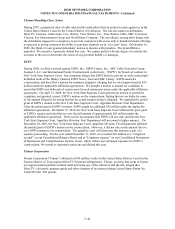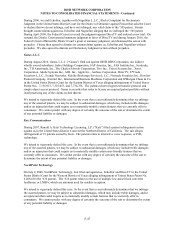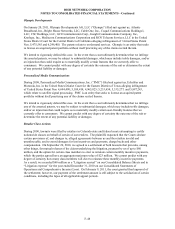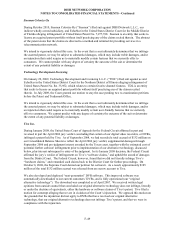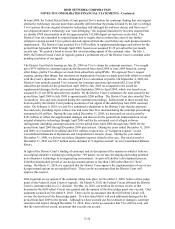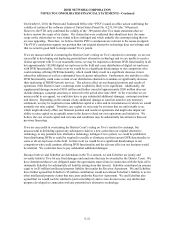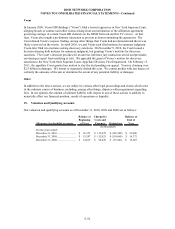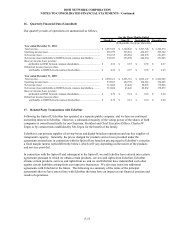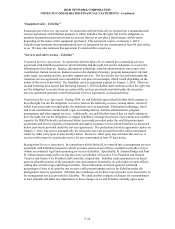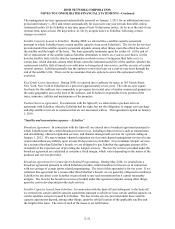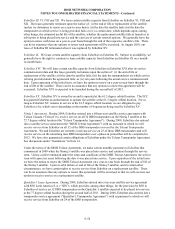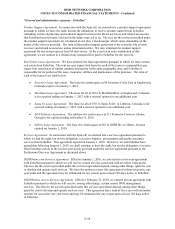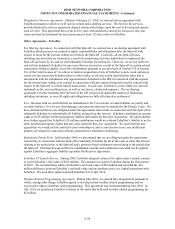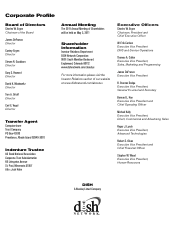Dish Network 2010 Annual Report Download - page 141
Download and view the complete annual report
Please find page 141 of the 2010 Dish Network annual report below. You can navigate through the pages in the report by either clicking on the pages listed below, or by using the keyword search tool below to find specific information within the annual report.
DISH NETWORK CORPORATION
NOTES TO CONSOLIDATED FINANCIAL STATEMENTS - Continued
F-56
EchoStar III, VI, VIII and XII. We lease certain satellite capacity from EchoStar on EchoStar VI, VIII and
XII. The leases generally terminate upon the earlier of: (i) the end of life or replacement of the satellite
(unless we determine to renew on a year-to-year basis); (ii) the date the satellite fails; (iii) the date the
transponder on which service is being provided fails; or (iv) a certain date, which depends upon, among
other things, the estimated useful life of the satellite, whether the replacement satellite fails at launch or in
orbit prior to being placed into service and the exercise of certain renewal options. We generally have the
option to renew each lease on a year-to-year basis through the end of the respective satellite’s life. There
can be no assurance that any options to renew such agreements will be exercised. In August 2010, our
lease of EchoStar III terminated when it was replaced by EchoStar XV.
EchoStar IX. We lease certain satellite capacity from EchoStar on EchoStar IX. Subject to availability, we
generally have the right to continue to lease satellite capacity from EchoStar on EchoStar IX on a month-
to-month basis.
EchoStar XVI. We will lease certain satellite capacity from EchoStar on EchoStar XVI after its service
commencement date and this lease generally terminates upon the earlier of: (i) the end of life or
replacement of the satellite; (ii) the date the satellite fails; (iii) the date the transponder(s) on which service
is being provided under the agreement fails; or (iv) ten years following the actual service commencement
date. Upon expiration of the initial term, we have the option to renew on a year-to-year basis through the
end of life of the satellite. There can be no assurance that any options to renew this agreement will be
exercised. EchoStar XVI is expected to be launched during the second half of 2012.
EchoStar XV. EchoStar XV is owned by us and is operated at the 61.5 degree orbital location. The FCC
has granted EchoStar an authorization to operate the satellite at the 61.5 degree orbital location. For so
long as EchoStar XV remains in service at the 61.5 degree orbital location, we are obligated to pay
EchoStar a fee, which varies depending on the number of frequencies being used by EchoStar XV.
Nimiq 5 Agreement. During 2009, EchoStar entered into a fifteen-year satellite service agreement with
Telesat Canada (“Telesat”) to receive service on all 32 DBS transponders on the Nimiq 5 satellite at the
72.7 degree orbital location (the “Telesat Transponder Agreement”). During 2009, EchoStar also entered
into a satellite service agreement (the “DISH Telesat Agreement”) with us, pursuant to which we will
receive service from EchoStar on all 32 of the DBS transponders covered by the Telesat Transponder
Agreement. We and EchoStar are currently receiving service on 23 of these DBS transponders and will
receive service on the remaining nine DBS transponders over a phase-in period that will be completed in
2012. We have also guaranteed certain obligations of EchoStar under the Telesat Transponder Agreement.
See discussions under “Guarantees” in Note 14.
Under the terms of the DISH Telesat Agreement, we make certain monthly payments to EchoStar that
commenced in 2009 when the Nimiq 5 satellite was placed into service and continue through the service
term. Unless earlier terminated under the terms and conditions of the DISH Telesat Agreement, the service
term will expire ten years following the date it was placed into service. Upon expiration of the initial term
we have the option to renew the DISH Telesat Agreement on a year-to-year basis through the end of life of
the Nimiq 5 satellite. Upon in-orbit failure or end of life of the Nimiq 5 satellite, and in certain other
circumstances, we have certain rights to receive service from EchoStar on a replacement satellite. There
can be no assurance that any options to renew this agreement will be exercised or that we will exercise our
option to receive service on a replacement satellite.
QuetzSat-1 Lease Agreement. During 2008, EchoStar entered into a ten-year satellite service agreement
with SES Latin America S.A. (“SES”), which provides, among other things, for the provision by SES to
EchoStar of service on 32 DBS transponders on the QuetzSat-1 satellite expected to be placed into service
at the 77 degree orbital location during the second half of 2011. During 2008, EchoStar also entered into a
transponder service agreement (“QuetzSat-1 Transponder Agreement”) with us pursuant to which we will
receive service from EchoStar on 24 of the DBS transponders.


